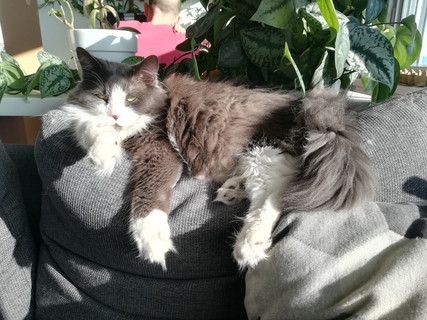Pigs and Progress: Invasive Species on Indigenous Land
- Mikaela Manley

- Mar 23, 2021
- 6 min read
Updated: Apr 5, 2021
Welcome back!
It’s been a few weeks since my last update. I’ve been finishing my last practicum placement these past few weeks in the same school and class as my community project, and has it been busy! I will say that balancing the two - planning, prepping, and teaching every day while also trying to create creative and separate materials for this project was difficult! Coffee, pet cuddles (Tilley and Mauser featured below), and my slowly growing plant wall (Snake plant featured) have definitely kept me grounded.
I do think that the difficulty of blending my goals seamlessly into a grade 11 biology context points towards its own systemic and structural problems, but I’ll speak to those later in this post. I do apologize for the lengthy post!
The Case Study: Invasive Wild Boars
I was able to implement a small class case study on the Wild Boar invasive species in Canada as part of this community project. We incorporated this into the Diversity of Living Things unit, having students explore the species Sus scrofa via dichotomous keys, nature and invasive species agency and media reports. We looked at national geographic and CBC articles, reports from the Nature Conservancy of Canada (NCC), Ontario Federation of Anglers and Hunters (OFAH), etc. Students created their own dichotomous key on how to recognize a Sus scrofa compared to other similar looking animals found in Canada, and answered a variety of questions about the invasive species.
They were asked to explore the question of where and why the boars came to Canada in the first place. Who brought them? How and why did that population come to Canada and why did they bring Wild Boars? How does the invasion of Wild Boars reflect other, similar, impacts that colonization has caused in Canada? I then had students listen to some of the profiles from CBC’s I Am Indigenous project that focused on Indigenous perspectives, knowledge, and connection to land and ecosystems to help inform their understanding and answers.
You can find a link to the I Am Indigenous project here: https://www.cbc.ca/news2/interactives/i-am-indigenous-2017/?fbclid=IwAR2w0W069LD_X6dC6EIIACJEj8LC4ttquvE9OGQtUVqVnHqGoGSW2LRnaEA

The final exploration was in three parts: a stakeholder analysis from 5 stakeholders of their choice about the topic as well as a written letter to the NCC with their chosen method of eradication of Sus scrofa and a defence as to why. We spoke about the importance of advocacy work and vocalizing concerns, and so I urged my students to actually send their letters to the NCC if they felt the issue important to them.
The final piece was homework, in which they researched what organizations are currently trying to tackle the problem in Canada, and analyzed the inclusion or lack thereof of Indigenous voices in those platforms. They asked and answered questions such as; are they including and listening to Indigenous voices in their strategy? Are Indigenous perspectives, voices, or collaboration mentioned in their strategy? Is the organization or effort Indigenous lead, co-lead, or collaborating with a specific Indigenous community?
I was SUPER impressed with the engagement in this activity, and the honesty they brought to some of their questions! I think I could have scaffolded the Indigenous perspectives and voices in a different and more authentic/effective way with a larger course-wide effort, but I speak to that below.
Centring Indigenous Voices in the Science Classroom
The purpose of having students explore Indigenous perspectives and ways of knowing around land usage and relationships with the environment was not for students to assume or fabricate what Indigenous communities may say about the wild boar invasive species, but rather to build an understanding of why it’s important for Indigenous voices and perspectives to be heard and included on the topic and decisions surrounding wild boar populations. I also wanted my students to hear different voices from a variety of Indigenous communities to help them break away from the often utilized colonial view that all Indigenous peoples and communities hold identical beliefs and viewpoints.
I felt that having Indigenous voices being central in discussing land usage and what it means from an Indigenous perspective to have a relationship with land and ecosystems moves us as science teachers away from the often single use stereotypical portrayal of Indigenous communities being in disarray from ecological disasters or lack of structural/housing/health support, etc. Not to say those issues aren’t incredibly important in creating awareness for our students and the lasting and continued marginalization and damage of colonialism. But I feel that the focus on empowerment, knowledge, and understanding that Indigenous communities bring to science is lost and often under appreciated.
Honestly, I sometimes find it quite difficult to find ways to authentically include Indigenous perspectives and ways of knowing into my pedagogy, and it makes me acutely aware of how that demonstrates the deep seeded colonial framework of my perspective and involvement with the Ontario curriculum, but also the curriculum itself. I think that shows a systemic failure on the curriculum development side that ignores authentic integration and Indigenous voices as a central tenet, but also it highlights my own limited sights, understandings, and approaches.
Racism and Meaning Making in Ecological Discussions and Science

This highlights a significant problem I feel our current curriculum creation has, which Beckford et al (2010) so articulately describes as how “the privileged and hegemonic dominance of Western knowlede has led to the marginalization and dismissal of Aboriginal and other Indigenous perspectives. Dominant Western research paradigms suppress Aboriginal Indigenous knowledge and this means that Aboriginal contributions are rarely found in environmental initiatives, which tend to be driven by the politics of formal science” (240). And the same rings true in the science classroom - Indigenous perspectives and experiences are often thrown in as a case study, an afterthought as a demonstration of western understandings.
We also need to critically engage with the ways in which dominant society has created and continues to create meaning around scientific knowledge, which knowledge holds power and meaning and which does not. Dicochea (2012) argues that these are racial-social constructs and that racism and social pressures around environmental resources developed alongside each other - intertwining so that the dominant and hegemonic structures of eco-justice are inherently filled with systemic racist, and I argue colonial, rhetoric. However, Dicochea does challenges us to look at the structures and systems at play in eco justice, and critically engage with and challenge the dominant rhetorics and the way in which meaning has been made in relation to socio-racial structures.
Working with the Walpole First Nations community, Beckford et al describe how important it is to centralize Indigenous ways of knowing in environmental education, as they “provide lessons that can help mainstream Canadian society reconnect with nature and establish mutually beneficial and reciprocal relationships.” (241), particularly in establishing responsible stewardship and the ethical obligations held in responsibly caring for nature and the environment (Beckford et al, 243). Lowan-Trudeau (2017) places this cantering of Indigenous voices as the ultimate form of resistance against these hegemonic rhetorics and racialized structures, and it is a tactic that I plan to continue pushing my own pedagogical practice to completely embrace and employ.
A Final Thought
I recognize that I have a long, long way to go on this. I feel frustrated with myself for at times my lack of effort, creativity, and my tokenistic use of Indigenous communities in the past. However, this just only means that I have more work to do on my own internalized biases and hegemonic belief structures around the creation of knowledge. This work will never end. There will always be more for me to do, my own personal beliefs, misconceptions, and actions to challenge. It can be uncomfortable to realize the ways in which you perpetuate racist and dominant structures, particularly when its embedded in something like eco-justice that I have clung to so vehemently to and has become deeply embedded in my own identity.
References
Beckford, C. L., Jacobs, C., Williams, N., & Nahdee, R. (2010). Aboriginal Wisdom,
Stewardship, and Sustainability: Lessons From the Walpole Island First Nations,
Ontario, Canada. The Journal of Environmental Education, 41(4), pp. 239-248.
Dicochea, P.R. (2012). Discourses of race and racism within environmental justice studies:
an eco-racial intervention. Ethnicity and Race in a Changing World: A Review
Journal, 3(2).
Lowan-Trudeau, G. (2017). Protest as pedagogy: Exploring teaching and learning in
Indigenous environmental movements. The Journal of Environmental Education,
48(2), pp 96-108.








Comments